|
Judging by the amount of press
it's garnered, the millions of books sold by dozens of authors
and the general buzz it continues to generate, Six Sigma--the
process improvement methodology introduced by Motorola in
the mid-1980s--is going strong. Whether you believe it's
here to stay or simply today's program du jour waiting to
be replaced by tomorrow's blue plate special, there's no
doubt that Six Sigma has greatly affected the businesses
that have embraced it, producing incredible cost savings
and waste reduction.
Our second annual Six Sigma Survey takes a snapshot of
who's using Six Sigma and, with the help of some notable
Six Sigma experts, focuses on the state of Six Sigma and
where it could be headed.
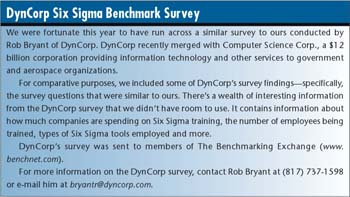 This
year, Quality Digest invited all of our approximately 75,000
readers plus the 12,500 members of our InsideQuality Web
site (www.insidequality.com) to participate in our survey.
We received 2,870 responses. Along with the results of our
survey, we've included comparative data from a similar survey
conducted by DynCorp. For more information on the DynCorp
Six Sigma Benchmark Survey, see the sidebar to the right. This
year, Quality Digest invited all of our approximately 75,000
readers plus the 12,500 members of our InsideQuality Web
site (www.insidequality.com) to participate in our survey.
We received 2,870 responses. Along with the results of our
survey, we've included comparative data from a similar survey
conducted by DynCorp. For more information on the DynCorp
Six Sigma Benchmark Survey, see the sidebar to the right.
The majority of the survey results can be seen in the
tables throughout this article. Rather than explain all
the results in detail, we'll leave it to you to look at
the tables while we focus on what we believe are two of
the most interesting findings: the lack of small companies
pursuing Six Sigma and why those who are using Six Sigma
seem to stop after three or four years.
Despite plenty of press, anecdotes and even surveys showing
huge Six Sigma successes, fewer than one-quarter (22%) of
all companies we surveyed have a Six Sigma program in place.
Ninety percent of the companies that do implement Six Sigma
are units, divisions or sites of larger organizations. Of
those, three-quarters belong to organizations with more
than 2,000 employees.
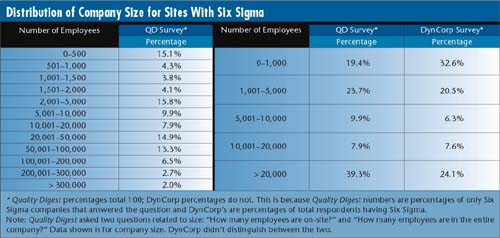

According to 1997 U.S. Census Bureau statistics, 98 percent
of U.S. firms had fewer than 20 employees, and 82 percent
grossed less than $1 million in sales in 1992. More than
30 percent of all sales or receipts for U.S. companies come
from companies with fewer than 100 employees. If Six Sigma
is truly yielding huge savings for the companies that use
it, then it stands to reason that small businesses need
Six Sigma in order to achieve the kind of cost savings and
increased profitability enjoyed by large-company Six Sigma
practitioners. By extension, this would aid the U.S. economy
as a whole.
Nevertheless, our surveys show that this isn't happening.
All of the experts we've spoken to say that the cost of
Six Sigma deployment and implementation is the reason. Some
consultants and Six Sigma Champions at large corporations
say that Six Sigma is achievable in small companies, but
they often define small companies as those with 500 or so
employees and sales of $50 million to $100 million, not
the 98 percent of U.S. operations that are truly "small
business."
Money and personnel are serious hurdles for small companies
when it comes to Six Sigma, agrees Mikel J. Harry, 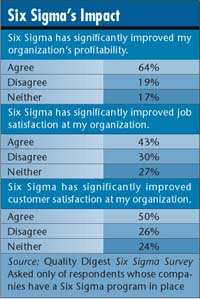 author
of the best-selling book Six Sigma, the Breakthrough Management
Strategy Revolutionizing the World's Top Corporations (Doubleday,
1999) and founder of Six Sigma Academy. author
of the best-selling book Six Sigma, the Breakthrough Management
Strategy Revolutionizing the World's Top Corporations (Doubleday,
1999) and founder of Six Sigma Academy.
"Smaller companies don't have the resources to train
the way that large-scale corporations do," says Harry,
whose large clients pay millions of dollars for in-house
Six Sigma training and consulting. "It's not just the
cost but the operational management in terms of human resources.
How many engineers can a company free up for four months
of learning?"
But with nearly 40 percent of all sales or receipts for
U.S. companies coming from companies grossing less than
$50 million, one would think that the more altruistic consultants
would view getting Six Sigma into the hands of small businesses--those
that can't afford it but form a substantial portion of U.S.
industry--as a crucial goal. Even from a purely mercenary
perspective, formulating a way to scale Six Sigma training
down to something affordable for small businesses would
open up a huge market for consultants.
Although refraining from going into a lot of detail on
the project, Harry reports he's working on a plan to do
just that. Within the next six months, he'll unveil details
of his Six Sigma Federation, which Harry describes as "a
collection of large-scale institutions coming together to
ensure the successful installation of second-generation
Six Sigma practices and principles into midsized and small-business
enterprises." The federation is specifically designed
to help small companies reap the Six Sigma benefits currently
realized by many of the large-scale corporations.
Consultants can't always offer their services at a price
small companies can afford, says Subir Chowdhury, chairman
and CEO of American Supplier Institute Consulting Group
and best-selling author of The Power of Six Sigma (Dearborn
Trade, 2001) and Design for Six Sigma (Dearborn Trade, 2002).
Big corporations can afford a quarter of a million dollars
or more to train Black Belts, says Chowdhury. "But
for a mom-and-pop shop to afford Black Belt training is
almost impossible," he acknowledges. "Consultants
have no mechanism to handle small companies." This
means that for Six Sigma to reach small businesses, the
onus would be on the consultants to find a way to do so.
"The people at the forefront of Six Sigma training,
like us, Mikel Harry and others, have to come forward to
help these organizations," says Chowdhury. "These
organizations have a lot of interest in Six Sigma, and we--consultants
in general--are not coming up with solutions for these companies."
Chowdhury says that ASI is adapting its programs to fit
the needs of companies that can't afford a full-blown Six
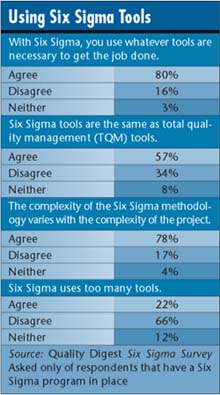 Sigma
program. Even at that, he admits that it's cost prohibitive
for most consultants to help companies that fall below $50
million in sales. Sigma
program. Even at that, he admits that it's cost prohibitive
for most consultants to help companies that fall below $50
million in sales.
Aside from cost and manpower issues, misperceptions about
who can "do" Six Sigma can deter small companies
from even looking at Six Sigma, says Phong Vu, director
for corporate Six Sigma at Ford Motor Co. Small companies
see the money and labor that companies like Ford spend and
immediately believe that's what a Six Sigma initiative requires,
he suggests.
"I think it's the perception of small companies that
they can't afford to train thousands of people," says
Vu, whose Six Sigma program involved training 1 percent
of Ford's employees as Black Belts and 30,000 employees
as Green Belts. "As Mikel Harry [Ford's Six Sigma consultant]
can tell you, when we started out it cost Ford $6 million.
Also, to teach Six Sigma, you have to deploy it to the whole
corporation, and that scares small companies."
This view isn't unfounded; the Six Sigma deployment model
is difficult for small companies. Having begun in large
corporations, the model for Six Sigma is based on deployment
in large organizations, notes Don Linsenmann, vice president
and Six Sigma corporate Champion at DuPont. "If you
look at the genesis of Six Sigma, the whole concept was
to find defects in discrete part manufacturing," he
explains. "Six Sigma started where there was a big
volume of stuff being made [e.g., cell phone parts]. Large
companies were able to use the tools that dealt with large
populations of articles and design an infrastructure to
reduce waste and cycle time. Because of the bureaucracy
[in large companies], there was room to organize some of
the talent around the idea of Six Sigma." Large companies
had the luxury of being able to pull out and train a corporate
Champion, small business unit Champions and thousands of
Black Belts and Green Belts, he explains. Small companies
don't have that luxury.
Add to this the cha-ching factor. As large companies scrambled
to follow suit with Motorola, AlliedSignal and the other
early adopters of Six Sigma, consultants geared up to provide
Six Sigma training services to large companies. "The
consultants had an early business model that aimed at big
pockets," Linsenmann points out. Small companies were
essentially ignored as consultants made millions helping
large companies save billions.
There are some ways that small companies can take advantage
of Six Sigma, say our experts.
Stacy Hanley, director of business development at Motorola
University, which offers both in-house and open-enrollment
courses, is optimistic about reaching companies with fewer
than 500 employees or receipts of less than $50 million.
"Six Sigma is, in fact, very scaleable," says
Hanley. "We think in terms of critical business objectives
and high-impact improvement projects that will reach those
objectives instead of the number of people and Black Belts
that need to be trained.
By getting clear on organizational goals and creating a
short list of high-impact improvement projects, then training
a handful of people to drive the completion of those projects
through Six Sigma, small and medium-sized companies can
experience the dramatic benefits of Six Sigma."
For companies that can't afford in-house training, open-enrollment
courses are cost-effective, says Hanley. Both Vu and Chowdhury
also acknowledge that taking off-site classes in Six Sigma
can be cost-effective; however, both caution that unless
the right people are sent and top management is involved,
the $10,000 to $15,000 per student cost will be wasted.
"The biggest mistake companies make is to send a
couple of guys from the quality department to an open-enrollment
course," agrees Vu. "They then go back to the
company but can't affect upper management. Somehow we have
to get the idea across that it doesn't have to be expensive,
but it has to start at the top."
Vu suggests that small companies employ the same mindset
as large companies when selling the idea of Six Sigma. Top
management has to be convinced that the upfront cost will
be more than made up by savings. The trick, says Vu, is
to try to sell Six Sigma as a capital investment rather
than a training exercise.
Linsenmann suggests that small companies not focus on
the Six Sigma support systems that large companies have
in place but rather on the attributes of those systems.
A 20-person company probably can't free up anyone to undergo
the kind of training necessary to get Six Sigma launched.
However, small companies can bring in a Master Black Belt,
who's not a consultant, to spearhead the deployment. This
person would be responsible for teaching employees Six Sigma
leadership concepts, tools and technologies. This training
could be supplemented by sending some employees to open-enrollment
courses.
Chowdhury suggests that if small companies pursue Six
Sigma, they should let someone with a long-term interest
in the company (e.g., someone from senior management) become
the Black Belt. Even among larger companies, a Black Belt
certificate makes you more valuable and more likely to be
hired away from your current employer. Although larger companies
can absorb a certain amount of this, it could be devastating
for a small company to invest in Black Belt training for
one or two employees only to see them hired by another firm
offering more money. This is less likely to happen if someone
with a vested interest in the small company becomes the
Black Belt, says Chowdhury.
Our 2001 and 2002 surveys and the DynCorp survey show
a drastic drop in the percentage of companies using Six
Sigma after the second or third year, as shown above.
There are several possible explanations for the drop.
The first is that although Six Sigma has been around for
a while, it has only gained mainstream popularity within
the last few years. This is due to press coverage of Six
Sigma successes at giants like GE and Motorola and the millions
of copies of books on the subject sold by Chowdhury, Harry
and others. What we could be seeing is the ramp-up of Six
Sigma adoption.
Another explanation is that companies are abandoning the
program. Not tying Six Sigma projects to corporate goals
and/or not leading the Six Sigma initiative by top management
almost guarantees the program will fail, say our experts.
"If you're doing Six Sigma and deriving the $350,000
per project savings that we've seen in the deployments I've
done, then you're going to stay with it," says Harry.
"If you go along with fluffy projects that aren't really
Six Sigma projects, and your top management doesn't see
a positive change in income or capacity, you're going to
scrap it."
The real issue as Harry sees it is that management is
seldom properly schooled in what constitutes a Six Sigma
project. Projects don't link to corporate goals.
"That tells us that Six Sigma is being led by middle
management and below," explains Harry. "This happens
because Six Sigma is brought in randomly across different
segments of the organization in no focused way. Implementation
and deployment was not rolled out from the top down. Six
Sigma is starting to suffer from that."
Another issue is that companies often view Six Sigma the
same way they view traditional quality control programs:
as a set of tools you use to solve a particular problem.
"Some companies define Six Sigma as a quality metric--the
goal of 3.4 defects per million," says Linsenmann.
"In such a company, Six Sigma is a technology and therefore
run by technologists. By contrast, at DuPont it's how we
do our work. It's the vision we're working toward. We have
to continually refresh and expand the domain to make it
relative to everyone."
For companies that see it as only a cost-reduction method
for manufacturing, Six Sigma won't survive. Once they wring
the maximum amount of improvement out of a set of tools,
the company will give up. The key is to look beyond simply
solving a particular problem.
"My experience is that a company says it wants to
achieve 3.4 defects per million," explains Chowdhury.
"After three years or so they hit the five-sigma wall
and they say, 'There's no way I can improve more.' After
two or three years, they haven't gotten what they wanted,
so they stop."
But you can only fix things so much, adds Chowdhury. The
next step is to go beyond using Six Sigma to fix what's
already there and instead design Six Sigma into the process.
Linsenmann agrees. "Even if you've milked out all
the defects, you can start with a clean sheet and use the
Six Sigma philosophy to build a process that won't have
defects and will run at a more effective rate," he
says. "If you don't do design for Six Sigma, you'll
hit a brick wall."
It has been Chowdhury's observation that this is where
many consultants shortchange their clients. "Ask consultants
what's more difficult, Six Sigma training or design for
Six Sigma, and they'll tell you design for Six Sigma,"
says Chowdhury. "But ask them how long their Six Sigma
training is and they'll tell you 20 days but only five days
for design for Six Sigma. The thing that will help break
through the five-sigma wall is design for Six Sigma, but
it receives the least amount of training from many consultants."
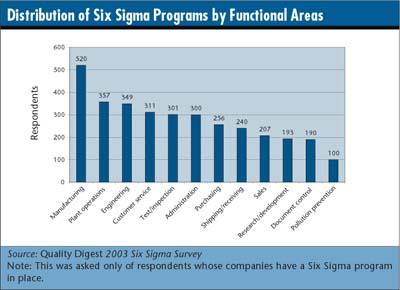 Certainly,
Six Sigma isn't the only program that companies can use
to help cut waste, improve quality and have a positive impact
on the bottom line. But, because it's set up to do so, it
provides well-documented results. It's those results and
the knowledge that one of the past decade's best tools is
out of reach for most small businesses that have caught
our attention. Certainly,
Six Sigma isn't the only program that companies can use
to help cut waste, improve quality and have a positive impact
on the bottom line. But, because it's set up to do so, it
provides well-documented results. It's those results and
the knowledge that one of the past decade's best tools is
out of reach for most small businesses that have caught
our attention.
Regardless of whether the program is Six Sigma, ISO 9000
or the next big thing, consultants should be looking at
how to get those programs into the hands of the companies
that make up the backbone of North American industry--the
small business.
It doesn't matter if you're a big or small company, complete
and total management buy-in is key to your quality program.
Without it, you're doomed to failure. Harry, Chowdhury and
the others all maintain that the first step to Six Sigma
is to sell top management on completely committing the company
to the effort.
"Leadership is 99 percent of getting Six Sigma installed,"
says Harry, summing up the importance of top-management
leadership. "It's selling hope and then leading them
[the employees] to it. Give them the vision of Oz, show
them the direction it's going and then convince them you
can create the yellow brick road. The rest is just civil
engineering."
We're interested in small company success stories in Six
Sigma. If your company has fewer than 100 employees or less
than $10 million in sales and has successfully deployed
Six Sigma, we want to hear from you. Please send an e-mail
to letters@qualitydigest.com with a brief description of
your company and how you're using Six Sigma. We may feature
you in an upcoming article.
Dirk Dusharme is Quality Digest's technology editor. Letters
to the editor regarding this article can be sent to letters@qualitydigest.com.
|